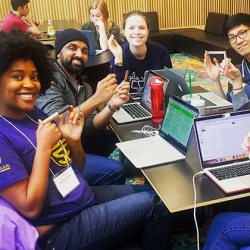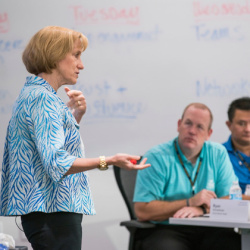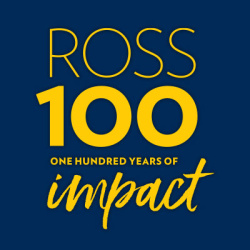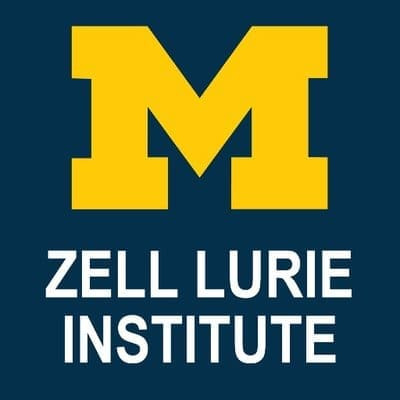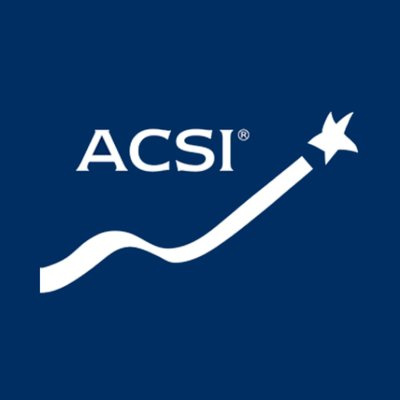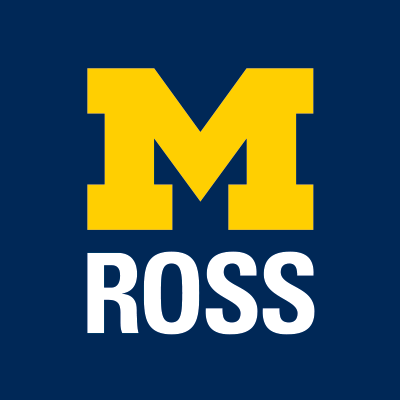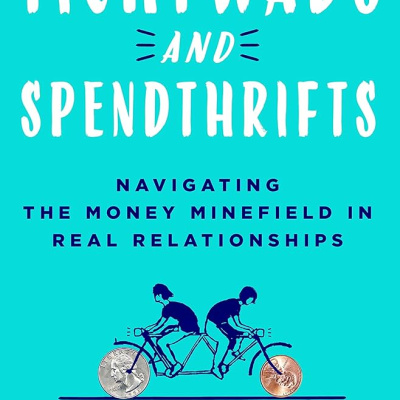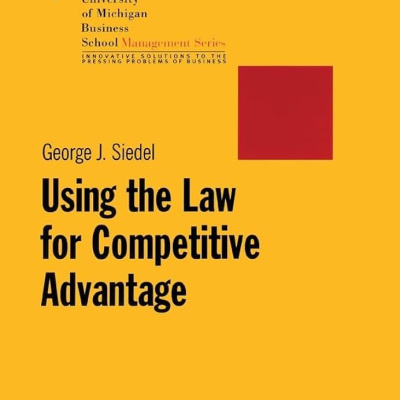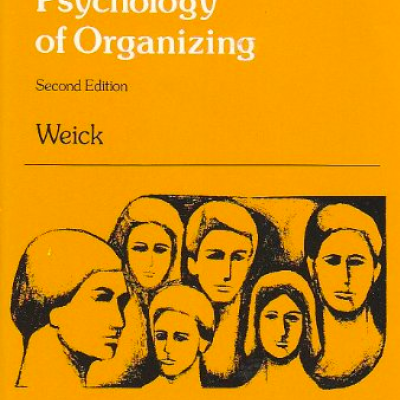Explore the faculty research, thought leadership, and groundbreaking philosophies that established Michigan Ross as one of the world’s top business schools.

Michigan Ross is known for being one of the first places to promote and provide rigorous evidence contrary to the efficient market hypothesis. The work of Professor Victor Bernard, a faculty member from 1982-1995, played a huge role in the beginnings of literature on market inefficiency. His work in valuation and fundamental analysis was the first to provide evidence that investors could not fully process information in earnings releases. The inefficient markets argument was further supported by the work of Professor Richard Sloan, a faculty member from 1997-2007. Bernard demonstrated that market participants treat the two basic components of accounting — cash and accruals — in an irrational way when making their valuation of corporate securities. This behavior became known as the "accrual anomaly." Bernard's work twice won the Notable Contribution to the Accounting Literature Award.

Professor Gautam Kaul and two former PhD students, in their seminal 1994 study titled, "Transactions, Volume, and Volatility" convincingly argued and verified empirically that it is the occurrence of a trade in a certain direction rather than its dollar value (or volume) that has the greatest effect on prices, hence the greatest relevance when assessing the liquidity of the market where that trade took place. A trade sign is determined by the buyer or seller's information, while market conditions determine trade amount and price. This is a simple yet extremely powerful notion that was originally predicated in theory but had no empirical support before their 1994 study. The publication of this study opened the door to the accurate measurement and needed assessment of market liquidity. These days, the approach they recommended is widespread in its use.

Sensory marketing is a relatively new and growing field of marketing that Professor Aradhna Krishna pioneered in the early 2000s. Krishna saw that there were disparate fields of study on senses, but there was no cohesion between these fields. She brought all these sub-fields together under the umbrella of sensory marketing and organized the first conference on it in 2008. She then wrote two books and dozens of scholarly articles on the subject to make the field grow. And the field did grow both in academia and in practice -- enough for Harvard Business Review to do a lead Ideawatch article on it featuring Krishna as the world's foremost expert on the topic. Krishna has defined "sensory marketing" as marketing that engages the consumers' senses and affects their perception, judgment, and behavior. Krishna continues to publish important, scholarly articles on the topic. She also started the Sensory Marketing Lab at Michigan Ross, which attracts PhD students and post-docs from around the world.

Established by Samuel Zell and Ann Lurie in 1999 as the first entrepreneurial studies program at the University of Michigan, the Zell Lurie Institute for Entrepreneurial Studies plays a vital role in developing the next generation of entrepreneurs and venture investors. The Institute offers various programs, competitions, and academic courses that give students the knowledge, skills, and motivation to develop a growth mindset and succeed as entrepreneurs.
Since its inception, the Institute has supported more than 9,100 entrepreneurs. It provides students with hands-on experience in entrepreneurial environments where they create, lead, and shape innovative ventures.
The Institute also supports venture investing and plays a key role in connecting entrepreneurs with venture capital and grant funding. This access to funding is crucial for entrepreneurs looking to start or scale their businesses and allows Ross students to act as real venture capitalists.

In the 1990s, a research team at Michigan Ross, led by Emeritus Professor Claes Fornell, created the American Customer Satisfaction Index. This groundbreaking project included Professors Eugene Anderson and Michael Johnson, as well as Research Scientist Jaesumg Cha and Barbara Everitt, former director of the U.S. Census Bureau.
ACSI represents a paradigm shift in measuring market performance, offering a more complete view of firms, industries, and economies and treats customer satisfaction as a latent construct connecting expectations, perceived quality and perceived value, through customer satisfaction, to customer voice and loyalty. For the past three decades, ACSI has catalyzed a wealth of peer-reviewed research in marketing and business. Empirical studies consistently find ACSI positively associated with profitability, cash flows, stock returns, credit ratings, positive earnings surprises, revenue, gross margins, return on investment, cash flow stability, and operating margins. Greater ACSI is also associated with lower cost of capital, cost of debt, and selling costs. At a macro level, ACSI is found to be predictive of gross domestic product.
Published research by the ACSI team enjoys wide recognition, garnering more than 100,000 citations. Additionally, ACSI-related research has played an outsized role in establishing customer satisfaction as an essential metric within firms' management information systems, priority setting, and key performance indicators.

If people don’t pay much attention to the ads when they watch TV, they can’t possibly think a lot about what the ads are saying. How, then, does advertising have the effects on consumer buying that it does? Showing that emotional responses evoked by the ad play an important role was a major research contribution by Rajeev Batra, Michigan Ross marketing professor. Batra came to U-M in 1989 from Columbia University, where he began this research stream. Over 10 years at MichiganRoss, he grew this research stream to show more clearly how these ad-evoked emotions interacted with the ads’ more rational content, what the different types of ad-evoked emotions were and how they could be measured accurately, and how they shaped consumers’ liking for and perceptions about brands. His co-authored papers on these topics have been cited more than 8,000 times, and he has twice been listed among the most influential scholars in the study of advertising. The methods he developed for measuring the types and effectiveness of emotional ads have also been incorporated into copy-testing systems at multiple ad agencies.
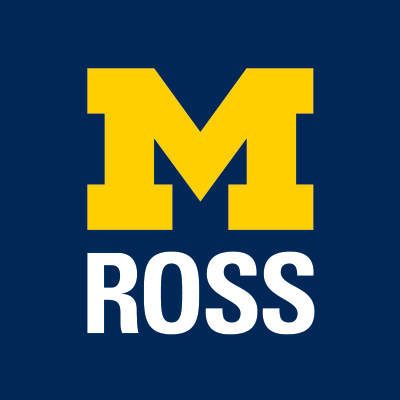
Professor Dudley Maynard Phelps, who was part of the Michigan Business School faculty from 1924-67, studied and wrote about the distinct marketing environments and challenges in markets as diverse as Latin America, Western Europe, and the former Soviet Union, including work for the U.S. State Department. He received recognition for this work from the International Marketing Institute and was president of the American Marketing Association. In the 1980s, Professor Vern Terpstra continued this work and authored the most widely used text on international marketing and other books on the cultural environment of international business, and also published highly impactful research on country-of-origin effects with his PhD student C. Min Han. Terpstra was president of the Academy of International Business in 1970 and was invited to teach at several universities.

The root of the Great Financial Crisis of 2008-2009 lay in poor-quality residential mortgage loans made by financial institutions. A set of academic research papers established that lenders made poorer quality loans when they anticipated selling the loans to investors rather than continuing to own the loans until they matured. When loans were sold, a complex securitization process led to a large distance between the originator of a mortgage and the final investor in the loans. Amit Seru, PhD '07, and co-authors established in an important series of papers that focused on 1) keeping most characteristics of loans the same, loans that were only marginally easier to securitize had significantly higher default rates than those that were marginally more difficult to securitize, 2) (in work with Professor Uday Rajan) securitized loans, the interest rate (which represents the compensation to investors for bearing the risk of default by the borrower) became an increasingly worse predictor of default in the build-up to the GFC, and 3) information passed on to investors by mortgage securitizers was limited and sometimes outright fraudulent. In another crucial strand of work, Professor Amiyatosh Purnanandam demonstrated that 1) loans held by banks on their own balance sheets had lower default rates than otherwise identical loans sold by banks to investors and 2) (in work with Taylor Begley, PhD '14, and Kuncheng Zheng, PhD '15) even with securitized loans, default rates were lower when the riskiest tranche was held by the lender rather than sold to investors. Collectively, the work done by Ross faculty and PhD alums showed that the ability to securitize mortgage loans undermined the incentives of lenders to the point that low-quality mortgage loans were made, essentially providing the dry timber that fueled the GFC.

Launched in 2014 by Michigan Ross and the Zell Lurie Institute for Entrepreneurial Studies, the Desai Accelerator is dedicated to advancing U-M alumni entrepreneurial ventures. The Accelerator provides the physical infrastructure, financial resources, and mentorship to support alumni startups as they reach the critical phase between early-stage development and the point at which they seek external investors.
At Desai Accelerator, startups can access a wide network of experienced advisors, including entrepreneurial mentors, industry experts, venture capitalists, angel investors, and other business leaders. To engage students, Desai offers internships for undergraduates and graduates from all U-M schools and colleges. The Desai Accelerator program runs an annual cohort that supports passionate entrepreneurs as they advance their early-stage ventures. Startups accepted into the program receive funding, tailored mentorship opportunities, national visibility, and other resources to support their success.
The Desai Accelerator has invested more than $1 million in 44 startup ventures on behalf of the University of Michigan and has engaged 75+ student interns. Funding and support for the Accelerator are provided by the Desai Sethi Family Foundation, the William Davidson Foundation, and the Wadhams Family Foundation.

In 2008, an article by Michigan Ross Professor Scott Rick changed how academics, practitioners, and the general public thought about consumers’ spending habits. The key insight was that many people who spend very little are frustrated with their behavior. They consistently spend less than they think they should, often with negative consequences for themselves and those around them. Under-spenders (“tightwads”) and over-spenders (“spendthrifts”) are two sides of the same coin: both experience conflict and distress around their spending habits. The scale Rick and colleagues developed to measure these tendencies has become widely used by marketing and psychology researchers. The tightwad-spendthrift construct attracted even more attention when Rick and colleagues demonstrated that tightwads and spendthrifts are more likely to marry one another than they are to marry someone like themselves. This “opposites attract” pattern is initially enjoyable, but eventually, as partners begin to confront a never-ending series of joint spending and saving decisions, tightwad-spendthrift differences harm relationship quality.
This research has attracted broad attention beyond the boundaries of marketing academia. It has been the topic of webinars, podcasts, and other features produced by the National Science Foundation, the American Psychological Association, the National Academy of Sciences, and the World Economic Forum. It has received years of sustained coverage from media outlets such as NPR, the New York Times, and the Wall Street Journal. Financial organizations like the CFP Board, ING, Charles Schwab, and Equifax have informed their clients and customers about the implications of this research. Most notably, in 2024, St. Martin’s Press published a mass-market book about this research, titled Tightwads and Spendthrifts: Navigating the Money Minefield in Real Relationships.

As the worlds of trade and culture were globalized in the 1980s, consumers worldwide saw standardized global brands enter and grow in their local markets, displacing local brands that had been dominant for decades. But what were consumers seeing in these global brands, and why were consumers switching to them? How could local brands fight back? These timely and important questions were addressed in a series of research papers by Michigan Ross Professor Rajeev Batra and his co-authors from 1999 through 2019. They showed that if consumers perceived brands as being global, they assumed these brands were of higher quality, capable of bestowing more prestige and status to their buyers, and would bring these buyers closer to the imagined lifestyles of consumers in the home countries of these brands. These papers have been cited over 6,000 times, have been nominated for and won multiple best-paper awards in journals and societies of international marketing, and have been included in lists of the 10 papers in the last 30 years that have made the most contribution to the international marketing literature. Today, as the lure of globalization seems to be receding and local brands seem to be winning again, this work highlights the tensions and trade-offs at play.

Professor David Hess is a thought leader in using new governance regulatory theory to advance the effective and efficient use of corporate monitors in U.S. and international settings. Hess and his co-authors published their first research on the topic in 2008 in the Cornell International Law Journal.
Since then, David has become a recognized thought leader with multiple published articles and book chapters on using monitors in settlement agreements to battle corruption and cultivate ethical behavior.
Based on his expertise, in 2013, the American Bar Association's Task Force on Standards for Monitors asked Hess to serve as its reporter. In 2020, the ABA published the 77-page Criminal Justice Monitors and Monitoring Standards. Hess' role as a reporter required that he draft and revise the standards before each meeting to reflect task force input.
This required legal research and drafting of explanatory memoranda as well as responding to comments and concerns of task force members and ABA officials. The Standards are used by companies, prosecutors, and judges when considering the use of corporate monitors with Deferred Prosecution Agreements or other settlement agreements resulting from concerns about fraud or other misconduct. The Standards may be used by other countries when establishing monitoring programs.
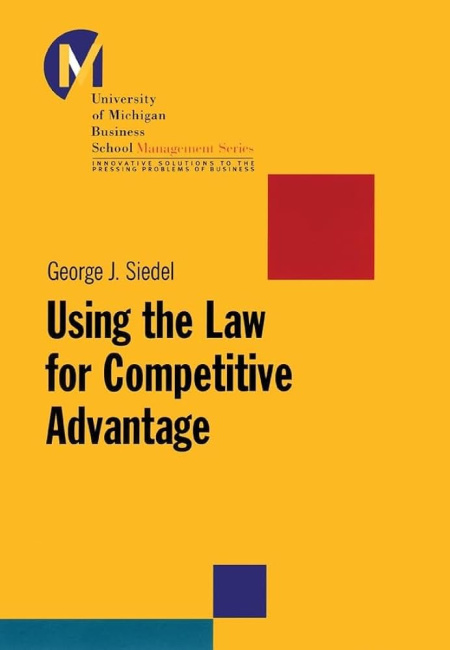
Professor George Siedel was a pioneer in developing the concept of law as a source of competitive advantage. This concept originated in his 2002 book: Using the Law for Competitive Advantage. In an article in the Academy of Management Executive, Robert Thomas (past president of the Academy of Legal Studies in Business), concluded that the book "is trailblazing in its assertion that legal issues are critical strategic variables in business planning." Siedel later emphasized an international dimension to his work in his 2010 book: Proactive Law for Managers: A Hidden Source of Competitive Advantage. This work has served as a foundation for academic and practitioner interest in the design and simplification of contracts and other legal documents.

Beginning from seminal efforts by Brian Talbot at the Michigan Business School in the early 1990s, the Tauber Institute for Global Operations was designed to bring business and engineering students together for a world-class education in operations. Students would take classes in both business and engineering and complete team projects with companies. The projects were scoped to incorporate both business and engineering content, addressing important problems that had a VP-level champion at the sponsoring company. The institute was innovative by offering additional training to students beyond operations: leadership training, communications training, and providing students the opportunity to organize conferences, etc. In addition to its impact on students and companies, the Institute has for years served as an important mechanism fueling the technology and operations faculty's relevant, problem-driven research by putting them in touch with practitioners at leading companies around the world. Since its foundation, more than 1,500 graduates have completed the program as Tauber Fellows, there have been 720 summer projects executed at 145 companies, and the Institute was honored in 2012 with the prestigious UPS George D. Smith Prize from INFORMS.

The 1996 book Competing for the Future by the late Professor C.K. Prahalad and his colleague, Gary Hamel from the London Business School, was unique in that it tied together several of Hamel and Prahalad's leading ideas into book format. The book introduces the concept of "core competencies," which emphasizes that organizations should focus on leveraging their inherent strengths and unique capabilities, and "strategic intent," which focuses on setting an ambitious, long-run vision for a firm's future. This emphasis on future thinking was a particularly notable aspect of the book. In general, the book advocated for a proactive approach to strategy where businesses actively envision and shape the trajectory of their respective industries instead of merely reacting to existing competitors and market dynamics in the short run. This emphasis on dynamics -- in particular, envisioning the future and then mobilizing strategy to compete in shaping it -- had important managerial implications for business thinking in the 1990s. It suggested that companies needed to transition from a short-term, reactive mindset to a more forward-thinking, visionary stance; this would allow companies not just to survive but dominate in future market landscapes. Overall, this book had a notable impact on business practice; Time Magazine named it one of "The 25 Most Influential Business Management Books."

Professor Karl Weick was an iconic founder of the field of organizational behavior. Starting with his seminal book, The Social Psychology of Organizing, which was published in 1969, Weick's ideas had enormous influence, shaping organizational scholarship over the next decades and to this day. He focused on the processes of organizing rather than on organizations per se, suggesting that the insights into those processes give us important leverage to both understand and affect life in organizations. In his book, he introduced the seminal concept of "sense-making," which he defined as "the ongoing retrospective development of plausible images that rationalize what people are doing." Weick's ongoing research focused on how individuals engaged in making meaning and how that meaning-making affected important outcomes in organizations. His book has been cited more than 35,000 times, and his other work on the topic has been cited more than 13,000 times. His pioneering work has instilled a highly influential perspective on the people attempting the organizing work that goes into organizations.

